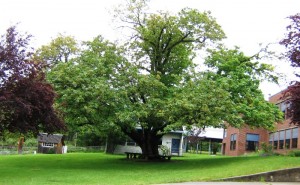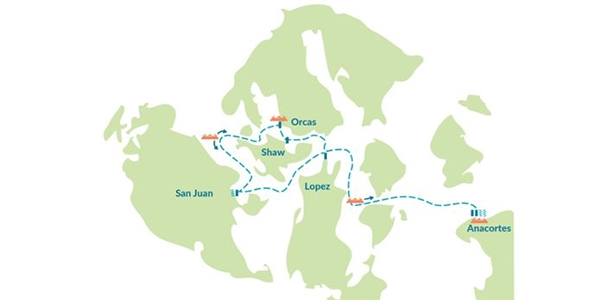It now appears that all that’s wrong with the venerable old maple tree in front of Nellie Milton (Orcas Island) Elementary School is that it’s over-loved and thirsty!
Indicates that years of happy feet treading the ground around the 105-year-old maple have compacted the soil so thoroughly that water can’t seep down to its roots.
Plans call to loosen the soil around the tree and perhaps shelter it from “smother-love” with a fence.
A report from Olaf Ribeiro, Ph.D. Certified Plan Pathologist and Arborist, conducted August 6 this year, concludes that the Big Leaf Maple’s “twig dieback and [poor] foilage coloration is probably… a result of dry soil conditions and/or nutrient imbalances.”
Decay previously noted on the south stem “appears to have calloused over at the presented time. ” The report finds “no signs of insects, fungus infections, sap flow…stress fracturaures…strucutral problems.. or decay. ”
However, soil examination showed that excessive amounts of phosphorus, potassium, calcium, iron and zinc inhibit the uptake of nutrients copper, iron, zinc, boron, calcium, magnesium. The pH is also high. Applying nitrogen, sulfur, copepr and manganese are expected to correct the imbalances.
Other recommendations are:
- remove all vegetation from around the base of the tree trunk;
- apply mycoremediation to improve root development;
- prune out dead branches;
- “Cobra cable” the two large stems;
- irrigate when soil condition is dry.
In early 2006 Herlwyn Lutz, certified arborist, found that symptoms of twig death was evident “mostly in the higher parts of the tree” and would “most likely continue.” He reported that “the wilt disease which plugs the [tree’s] water carrying vessels was progressing. ”
Lutz also stated that “considering…the strength of the wood as evidenced by the solid cores from the drillings, the tree may remain,” although he added that his report “could not guarantee that failure will not occur.”
After meeting with Superintendent Kline this spring to determine if action was needed, Lutz reviewed a current core drilling finding only solid wood, and recommended waiting on tree removal.
In a supplement written this summer, Lutz noted that since 2006, he’d removed some dead limbs and “a few live laterals in order to reduce the weight on those large structural limbs growing toward west and north.”
Lutz has offered, and continues to offer, his professional services free of charge “as a community service.”
He agrees with the Ribeiro report which concludes, “This tree appears therefore, to be in a fairly healthy state for a maple tree of this age.”
**If you are reading theOrcasonian for free, thank your fellow islanders. If you would like to support theOrcasonian CLICK HERE to set your modestly-priced, voluntary subscription. Otherwise, no worries; we’re happy to share with you.**







